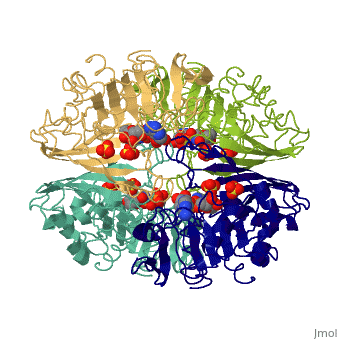Sandbox Reserved 470: Difference between revisions
No edit summary |
No edit summary |
||
| Line 4: | Line 4: | ||
---- | ---- | ||
'''[[Glyceraldehyde-3-phosphate Dehydrogenase]]''' | '''[[Glyceraldehyde-3-phosphate Dehydrogenase]]''' | ||
<Structure load='3gpd' size='400' frame='true' align='right' caption='Glyceraldehyde-3-phosphate Dehydrogenase' scene='Insert optional scene name here' />(abbreviated as GAPDH or the less common G3PDH) (EC 1.2.1.12) ~37kDa is a well-known [enzyme] which catalyzes the sixth step of [glycolysis], a reversible cytosolic process in [eukaryotes] which involves the breakdown of glucose for energy and carbon molecules. Along with its role in glycolysis and [gluconeogenesis], recent research has determined that GAPDH is actually a multifunctional protein, as it has numerous defined, non-metabolic functions involved in multiple subcellular processes including [transcription] activation, ER to Golgi transportation, transcriptional control of histone [gene expression], nuclear membrane fusion, neuronal initiation of [apoptosis], recognizing fraudulently incorporated nucleotides in DNA, and maintaining [telomere] structures. Research also shows that it possibly has a direct involvement in cellular phenotype of human [neurodegenerative] disorders, especially those characterized by expansion of [CAG repeats]. | <Structure load='3gpd' size='400' frame='true' align='right' caption='Glyceraldehyde-3-phosphate Dehydrogenase' scene='Insert optional scene name here' />(abbreviated as GAPDH or the less common G3PDH) (EC 1.2.1.12) ~37kDa is a well-known [[enzyme]] which catalyzes the sixth step of [glycolysis], a reversible cytosolic process in [eukaryotes] which involves the breakdown of glucose for energy and carbon molecules. Along with its role in glycolysis and [gluconeogenesis], recent research has determined that GAPDH is actually a multifunctional protein, as it has numerous defined, non-metabolic functions involved in multiple subcellular processes including [transcription] activation, ER to Golgi transportation, transcriptional control of histone [gene expression], nuclear membrane fusion, neuronal initiation of [apoptosis], recognizing fraudulently incorporated nucleotides in DNA, and maintaining [telomere] structures. Research also shows that it possibly has a direct involvement in cellular phenotype of human [neurodegenerative] disorders, especially those characterized by expansion of [CAG repeats]. | ||
---- | ---- | ||
'''Role in Glycolysis:''' | '''Role in Glycolysis:''' | ||
Revision as of 04:10, 2 May 2012
| This Sandbox is Reserved from 13/03/2012, through 01/06/2012 for use in the course "Proteins and Molecular Mechanisms" taught by Robert B. Rose at the North Carolina State University, Raleigh, NC USA. This reservation includes Sandbox Reserved 451 through Sandbox Reserved 500. | ||||||
To get started:
More help: Help:Editing For more help, look at this link: http://www.proteopedia.org/wiki/index.php/Help:Getting_Started_in_Proteopedia Glyceraldehyde-3-phosphate Dehydrogenase
Role in Glycolysis:
Other roles: The importance of GAPDH in transcription was discovered by Zheng et. al. in 2003. It was found that OCA's transcriptional coactivator complex contains GAPDH, which moves between the cytosol and nucleus and may link the metabolic state to gene transcription. In 2005 the initiation of apoptosis was shown to be mediated by GAPDH by Hara et. al. when it was found to bind to DNA like it does in transcription activation. GAPDH was also found to be involved in ER to Golgi transport because it is recruited by rab2 to vesicular-tubular clusters of the endoplasmic reticulum where it helps form COP 1 vesicles. It was also found that GAPDH is plays a role in certain neruodegenerative disorders, as is able to find stretches which are encoded by the gene's CAG repeats and bind to the gene products formed from disorders such as Huntington's disease, Alzheimer’s disease, Parkinson’s disease and Machado-Joseph disease. Use in the lab: Overall, GAPDH is a “housekeeping gene” and is found in high levels in tissues and cells so it is commonly used in biological research as a loading control in western blot and RT-PCR, but it has to be carefully controlled because under specific conditions it can have various regulation. |

